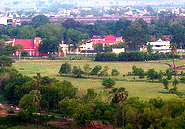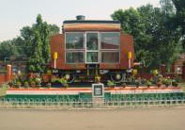Welcome to Jamalpur the world’s most beautiful place! Munger, Bihar
Welcome to Jamalpur ||Munger, BiharJamalpur Workshop
This was the first full-fledged railway workshop facilities in India, set up on Feb. 8, 1862 by the East Indian Railway. (There was an earlier attempt to set up workshop facilities at Howrah, but it proved unsuccessful because of problems with procuring supplies and getting skilled labour.) The Jamalpur site was chosen for its proximity both to the Sahibganj loop (which was the main trunk route at the time), and to the communities of gunsmiths and other mechanical craftsmen in Bihar who would prove to be adept at picking up the skills required in a railway workshop.
Another, possibly apocryphal account, though, has it that one of the Agents of the EIR Mr D W Campbell, was annoyed that the fitters and workmen of the then Howrah workshop were spending too much time away from their work in places of recreation in Howrah, and resolved to move the workshop facilities to a place far away where there would be no such distractions.
At first the Jamalpur shops were merely repairing locomotives and also assembling locomotives from parts salvaged from other, damaged locomotives. By the turn of the century, however, they had progressed to producing their own locomotives. The first one, CA 764 ‘Lady Curzon’, was produced in 1899.
Jamalpur has always had extensive workshop facilities. In 1893, the first railway foundry in India was set up there. It also had a boiler workshop for repairing and building boilers. Today it has foundry and metallurgical lab facilities, extensive machine tool facilities, etc., in addition a captive power plant of 5MVA, making it fairly self-contained. It used to have a rolling mill of its own (set up in 1870, now closed – the Rolling Mill and the Nut & Bolt Shop were closed down in 1984).
In addition to various repairs of wagons, coaches, cranes and tower cars, and locomotives, Jamalpur Workshop also undertakes repair and (small-scale) production of permanent-way fixtures. It also manufactures some tower cars (Mark II, Mark III) and break-down cranes of 10, 20, and 140 tonne capacities, besides various kinds of heavy-duty lifting jacks.
Finally, it also manufactures wheelsets for coaches and wagons. In the past it was a significant supplier of cast-iron sleepers as well. Starting in 1961 it produced several rail cranes. It has also produced electric arc furnaces, ticket printers and other ticket machines (slitting, counting, and chopping). The high-capacity synchronized lifting jacks known as ‘Jamalpur Jacks’ were also produced by this workshop.
The school attached to the Jamalpur workshops eventually became the IR Institute of Mechanical and Electrical Engineering.
3 Comments»
how to apply for training in your workshop plz tell me ?















MY Grandfather, Major R.V.Sitaraman, was the Principal of the ‘Railway Technical School’ at Jamalpur. He retired in 1955 and settled in Bangalore . I am proud to be his grandson and followed his footsteps in pursuing a carrer in Engineering and retired in 2009 July as Scientist Engineer S’F’ ,having served in ISRO, Bangalore, working in the Reliability Assurance, T&E of Spacecraft subsystems, Systems Rel.Group. I am browsing your Website for information and images of my Grandfather. Kindly send me some pictures of my Grandpa’s illustrive association with the Technical School.
Regards,
Tilak Swamy.
My grandfather worked there too in late 1940’s his name was Edwin Samuel do you know anything about him?